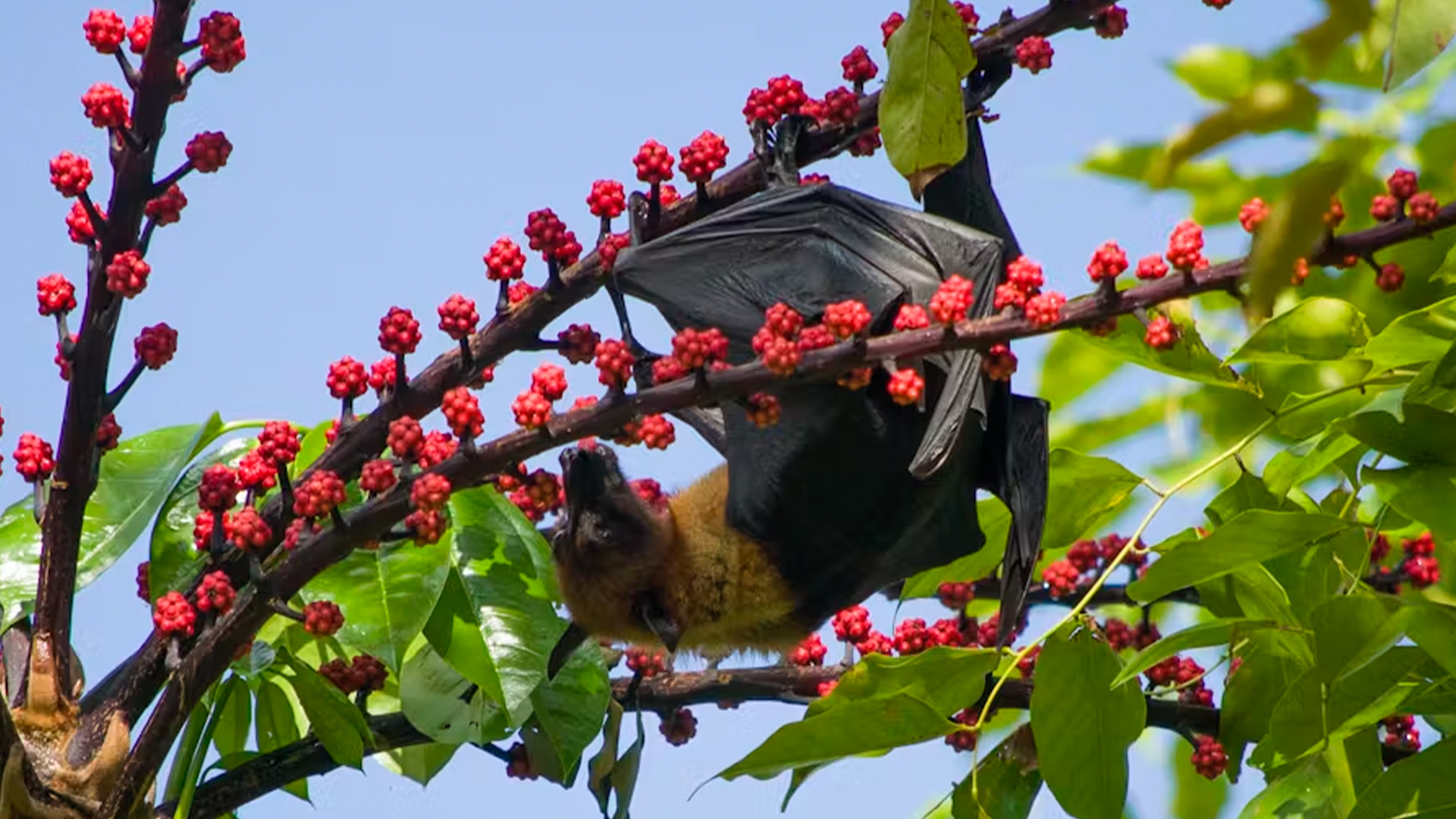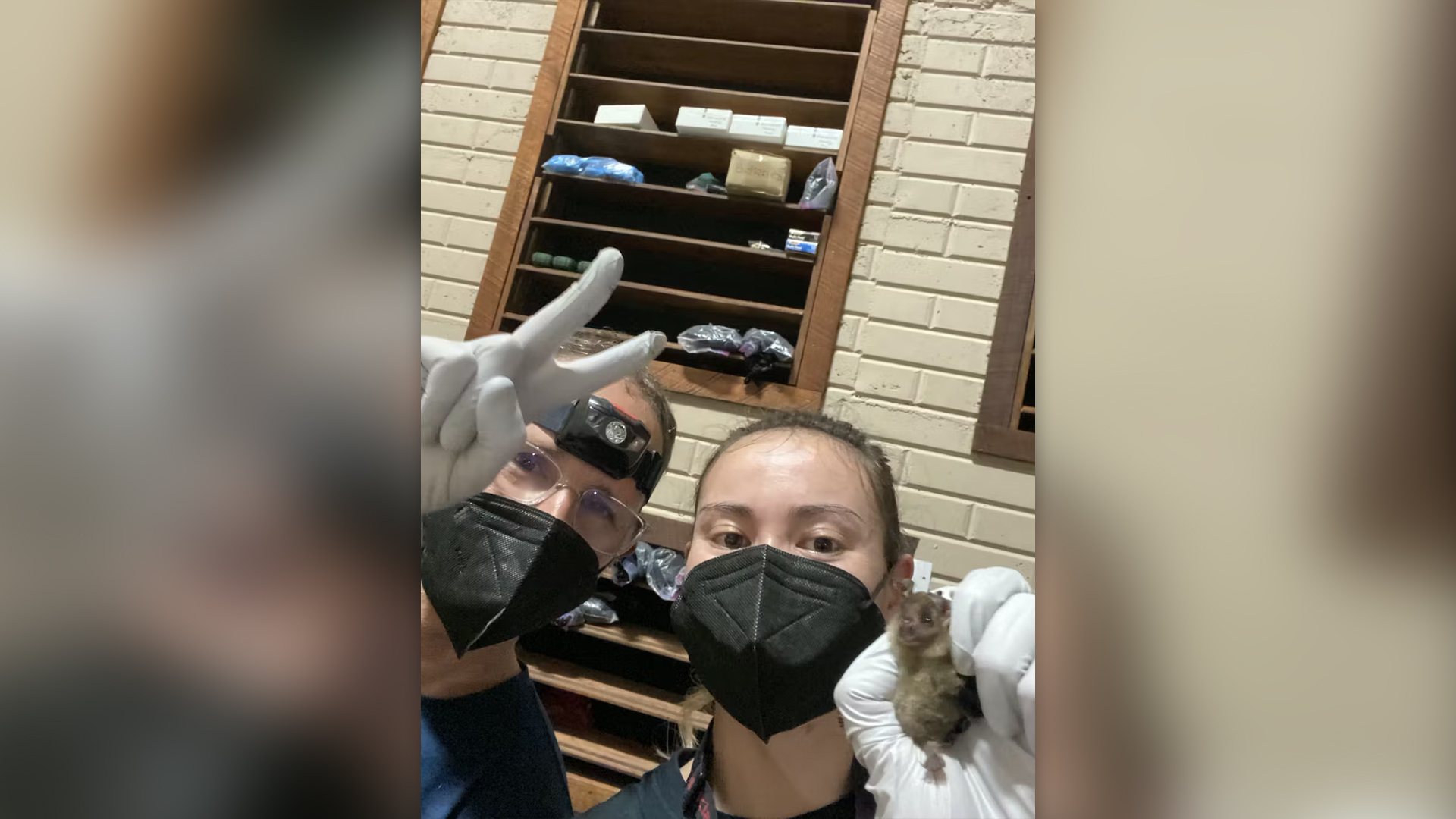Sugar-loving fruit bats' genes could point to new diabetes treatments, scientists say
Scientists are studying how fruit bats can handle such a sugary diet in order to potentially uncover new ways to manage humans' glucose levels.

Humans are not the only mammals that love sugar. Fruit bats do, too, eating up to twice their body weight in sugary fruit a day. However, unlike humans, fruit bats thrive on a sugar-rich diet. They can lower their blood sugar faster than bats that rely on insects as their main food source.
We are a team of biologists and bioengineers. Determining how fruit bats evolved to specialize on a high-sugar diet sent us on a quest to approach diabetes therapy from an unusual angle — one that sent us all the way to Lamanai, Belize, for the Belize Bat-a-thon, an annual gathering where researchers collect and study bats. Diabetes, the ninth leading cause of death in 2019, can emerge when the body is unable to process sugar effectively, leading to excess glucose in the blood.
In our newly published research in Nature Communications, we and colleagues Seungbyn Baek and Martin Hemberg used a technology that analyzes the DNA of individual cells to compare the unique metabolic instructions encoded in the genome of the Jamaican fruit bat, Artibeus jamaicensis, with those in the genome of the insect-eating big brown bat, Eptesicus fuscus.
Approximately 2% of DNA is composed of genes, which are segments of DNA that contain the instructions cells use to create certain traits, such as a longer tongue in fruit bats. The other 98% are segments of DNA that regulate genes and determine the presence and absence of the traits they encode.
To understand how fruit bats evolved to consume so much sugar, we wanted to identify the genetic and cellular differences between bats that eat fruit and bats that eat insects. Specifically, we looked at the genes, regulatory DNA and cell types in two significant organs involved in metabolic disease: the pancreas and the kidney.
The pancreas regulates blood sugar and appetite by secreting hormones like insulin, which lowers your blood sugar, and glucagon, which raises your blood sugar. We found Jamaican fruit bats have more insulin-producing and glucagon-producing cells than big brown bats, along with regulatory DNA that primes fruit bat pancreatic cells to initiate production of insulin and glucagon. Together these two hormones work to keep blood sugar levels balanced even when the fruit bats are eating large amounts of sugar.
The kidney filters metabolic waste from the blood, maintains water and salt balance and regulates blood pressure. Fruit bat kidneys need to be equipped to remove from their bloodstreams the large amounts of water that come from fruit while retaining the low amounts of salt in fruit. We found Jamaican fruit bats have adjusted the compositions of their kidney cells in accordance with their diet, reducing the number of urine-concentrating cells so their urine is more diluted with water compared with big brown bats.
Get the world’s most fascinating discoveries delivered straight to your inbox.
Why it matters
Diabetes is one of the most expensive chronic conditions in the world. The U.S. spent US$412.9 billion in 2022 on direct medical costs and indirect costs related to diabetes.
Most approaches to developing new treatments for diabetes are based on traditional laboratory animals such as mice because they are easy to reproduce and study in a lab. But outside the lab, there exist mammals like fruit bats that have actually evolved to withstand high sugar loads. Figuring out how these mammals deal with high sugar loads can help researchers identify new approaches to treat diabetes.
By applying new cell characterization technologies on these nonmodel organisms, or organisms researchers don't usually use for research in the lab, we and a growing body of researchers show that nature could be leveraged to develop novel treatment approaches for disease.
What still isn't known
While our study revealed many potential therapeutic targets for diabetes, more research needs to be done to demonstrate whether our fruit bat DNA sequences can help understand, manage or cure diabetes in humans.
Some of our fruit bat findings may be unrelated to metabolism or are specific only to Jamaican fruit bats. There are close to 200 species of fruit bats. Studying more bats will help researchers clarify which fruit bat DNA sequences are relevant for diabetes treatment.
Our study also focused only on bat pancreases and kidneys. Analyzing other organs involved in metabolism, such as the liver and small intestine, will help researchers more comprehensively understand fruit bat metabolism and design appropriate treatments.
What's next
Our team is now testing the regulatory DNA sequences that allow fruit bats to eat so much sugar and checking whether we can use them to better regulate how people respond to glucose.
We are doing this by swapping the regulatory DNA sequences in mice with those of fruit bats and testing their effects on how well these mice manage their glucose levels.
This edited article is republished from The Conversation under a Creative Commons license. Read the original article.
Dr. Gordon is Assistant Professor of Biology at Menlo College. This is her first year teaching at Menlo College. Dr. Gordon went to graduate school to become an undergraduate professor and work at a student-focused institution. Prior to joining faculty, Dr. Gordon taught graduate courses at UC San Francisco and undergraduate courses at University of San Francisco, San Francisco State University, and UC San Diego, as well as elementary courses at San Francisco public schools. At Menlo College, Dr. Gordon is focusing on improving STEM interest in STEM-underrepresented groups and connecting students to their surrounding biotechnology hub.
Dr. Gordon first began research at the Ocean Institute in Dana Point, California, where she worked as a husbandry intern. She conducted an artificial reef habitation project with local swell sharks and launched an aquaponics education exhibit. Dr. Gordon went on to work as a husbandry intern in the lab of Dr. Deborah Yelon at UC San Diego, where she migrated to the laboratory bench to study zebrafish heart development. Dr. Gordon simultaneously worked in the lab of Dr. Maike Sander at Sanford Consortium for Regenerative Medicine as a lab assistant and, later, the lab of Dr. Amro Hamdoun at Scripps Institution of Oceanography as an undergraduate researcher and URS (David Marc Belkin Memorial Research Scholarship for Environment and Ecology). While learning about drug transporters and embryonic development with sea urchins in Dr. Hamdoun's lab, Dr. Gordon pioneered a collaborative project between the labs of Dr. Hamdoun and Dr. Yelon, identifying a cell type in the zebrafish embryo that likely protects embryonic development from harmful small molecules (Gordon et al., Aquatic Toxicology, 2019).
As a graduate student, Dr. Gordon joined the lab of Dr. Nadav Ahituv at UC San Francisco to investigate the genetic factors underlying the evolution of frugivory (fruit-specialization) in mammals. By studying the DNA of mammals that adapted to high sugar diets, bats and primates, Dr. Gordon and her collaborators can identify novel DNA targets for therapies for metabolic diseases in humans like diabetes. Dr. Gordon utilized both comparative genomics and functional genomics techniques for her investigation, and she also traveled to Belize to work with bats and other bat researchers across the globe at the "Bat-a-thon." Dr. Gordon was awarded the NSF GRFP and also acquired an NIH EDGE CMT grant with Dr. Ahituv to advance her research. Dr. Gordon discovered many frugivory adaptations in the fruit bat kidney and pancreas, including differentially active genes and regulatory regions involved in fluid and electrolyte balance in the frugivore kidney and an increase in endocrine and a decrease in exocrine cells in the frugivore pancreas (Gordon and Baek et al., BioRxiv, 2023). More of Dr. Gordon's work will be published in the coming years.
Dr. Gordon's research at Menlo College will be on general biology education. She will be testing a variety of techniques and collecting data. Ultimately, she intends to use her genetics expertise to develop new courses at Menlo College that are in line with student interests and prepare students to become positive leaders of change in fast-growing biotechnological spaces of genomics, gene therapy, and pharma.





